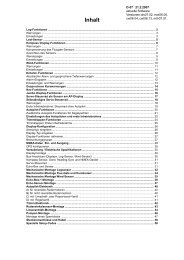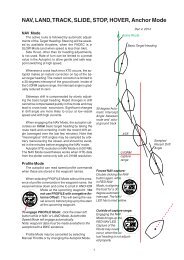Display Function - Marine Autopilots, Engine Controls and Instruments
Display Function - Marine Autopilots, Engine Controls and Instruments
Display Function - Marine Autopilots, Engine Controls and Instruments
Create successful ePaper yourself
Turn your PDF publications into a flip-book with our unique Google optimized e-Paper software.
Compass Compensation:<br />
do alignment first!<br />
Sensor compensation <strong>and</strong> alignment function<br />
are only accessible on the display unit, to<br />
which the sensor is physically connected via<br />
the NMEA port, <strong>and</strong> the port has been properly<br />
configured n0=01 for the primary compass<br />
or n0=02 for a secondary compass, <strong>and</strong><br />
n1=00 for the HS8000 or n1=07 for the PB200<br />
or H2183.<br />
Aligning the Sensor<br />
<br />
Reading the previously<br />
saved alignment<br />
correction<br />
1. Press <strong>and</strong> hold<br />
left <strong>and</strong> right button.<br />
2. Press middle<br />
AP<br />
button twice.<br />
3. Release all<br />
three buttons.<br />
For example<br />
"C_02" will st<strong>and</strong> for an<br />
alignment correction of +2 degrees. The value<br />
may be modified with the left or right button. This<br />
correction is added automatically to the sensed<br />
heading. Press the middle button again to display<br />
the compensation status function.<br />
Alignment Procedure<br />
First you need to create a deviation table. That<br />
will be the basis for a correct sensor alignment.<br />
The deviation table might have positive <strong>and</strong> negative<br />
numbers over the full circle.<br />
A deviation table can only be created by taking<br />
relative bearings of distant objects <strong>and</strong> comparing<br />
them with the indicated heading. Never<br />
use GPS tracks to build a deviation table.<br />
With the table at h<strong>and</strong>, adjust the alignment<br />
correction "C" (offset) until negative <strong>and</strong> positive<br />
deviation values become equal in size.<br />
Note: on the PB100/200 sensor, the offset<br />
correction will also be valid for the apparent wind<br />
angle.<br />
ATTENTION: the Alignment Correction may<br />
not be displayed correctly after (re-) installing<br />
either the sensor or the display unit, to which<br />
the sensor is connected. The correction must<br />
be verified in this case.<br />
<br />
<br />
Compensation<br />
Status <strong>Display</strong>:<br />
The compensation<br />
status display follows<br />
the alignment correction<br />
display (see left).<br />
means "not<br />
compensated",<br />
means "compensated".<br />
AP<br />
ATTENTION: compensation<br />
status is not<br />
correctly displayed after<br />
a new installation or after<br />
the sensor or display have<br />
been replaced.<br />
A new compensation<br />
can be started by briefly<br />
pressing the left or right button (see below).<br />
The middle button exits from the compensation<br />
function.<br />
Starting a new compensation<br />
cycle<br />
1. Select the compensation<br />
status on the<br />
<strong>Display</strong> (see above).<br />
2. Briefly press the<br />
left or right button.<br />
3. Start turning (for<br />
the HS8000 a starboard<br />
turn through 540<br />
degrees is required, for<br />
other sensors only a full<br />
turn to either side is<br />
needed).<br />
The turn has to be completed<br />
within one to three minutes<br />
<strong>and</strong> must be executed under perfectly<br />
smooth conditions. The vessel must not be<br />
heeled. Power lines or steel structures below or<br />
near the vessel must be avoided. A significant<br />
depth <strong>and</strong> a distance of several hundred meters<br />
(a few hundred yards) from bridges or buildings<br />
would present acceptable conditions.<br />
Completion of a compensation cycle is indicated<br />
by CAL-Auto (or by CAL-OFF if not successful).<br />
WARNING: executing a compensation bears<br />
the risk of introducing large compensation errors.<br />
A bad compensation can only be overwritten<br />
by a good one. The quality of a compensation<br />
cycle has to be verified with a newly produced<br />
deviation table.<br />
7




